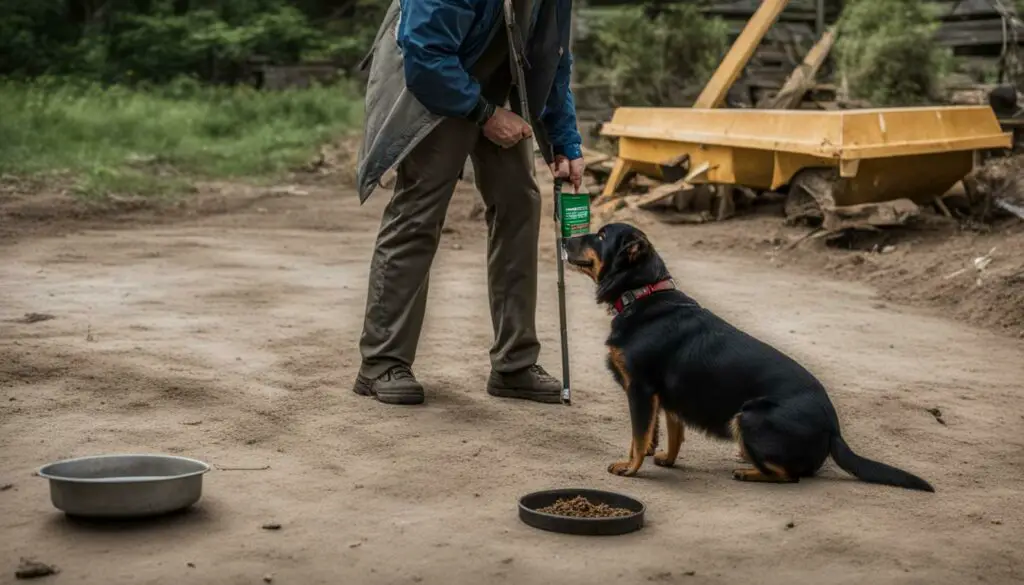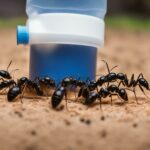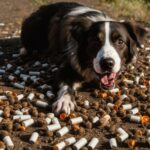Discovering that your dog has eaten an ant trap can be alarming, but it’s important to stay calm and take the necessary steps to protect your furry friend’s health. While most ant traps won’t cause serious harm to dogs, it’s crucial to be prepared for potential adverse health reactions. Immediate actions must be taken to ensure your dog’s safety.
If your dog has ingested an ant trap, it’s essential to monitor them closely for any symptoms of poisoning or discomfort. Contacting a pet poison helpline or veterinarian is recommended to seek professional advice tailored to your specific situation. Remember, your dog’s well-being is of utmost importance.
Key Takeaways:
- Stay calm and take immediate action if your dog has eaten an ant trap.
- Monitor your dog for any adverse health reactions or symptoms of poisoning.
- Contact a pet poison helpline or veterinarian for professional guidance.
- Assess your dog’s condition, checking for any visible damage to the mouth or throat.
- Keep an eye out for signs of intestinal blockage or perforation in the following 48 hours.
Understanding the Risks of Ant Traps for Dogs
Ant traps, though effective against insects, can pose serious risks to your dog’s well-being if ingested. These traps are designed to attract ants with a sweet-smelling bait, which often contains chemicals that are toxic to pets. When your dog consumes an ant trap, they are at risk of experiencing adverse health reactions that can vary in severity depending on the type of trap ingested and the size of your dog. It is crucial to be aware of the potential dangers and take immediate actions to ensure your dog’s safety.
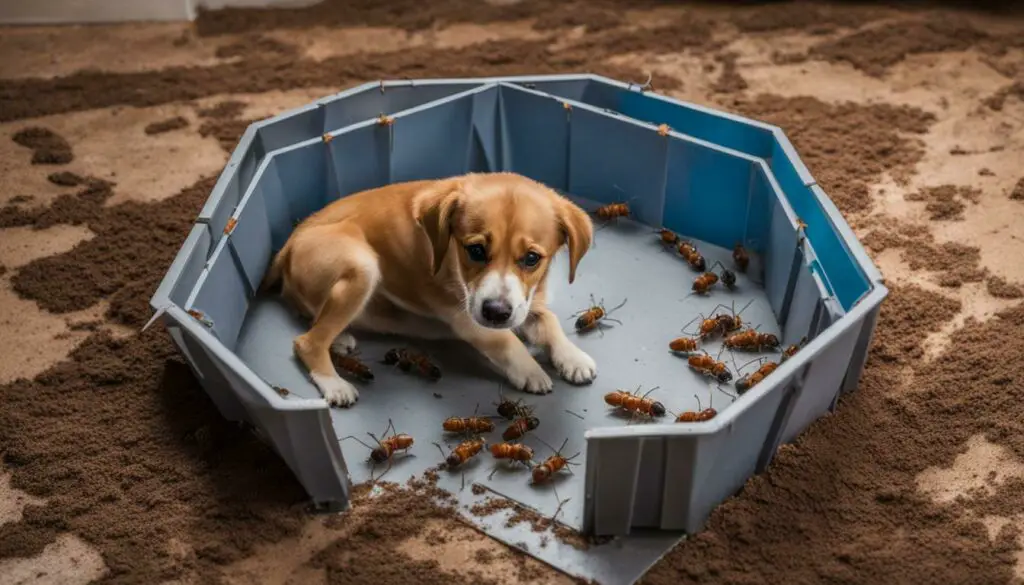
Toxicity is the primary concern when it comes to ant trap ingestion. The chemicals found in these traps can cause various symptoms of poisoning in your dog. These may include drooling, vomiting, diarrhea, tremors, seizures, weakness, and difficulty breathing. In severe cases, ingestion of ant traps can lead to organ damage or even be fatal for your beloved pet. It is essential to act swiftly and effectively to minimize the risks and provide the necessary care for your dog.
Signs of Ant Trap Poisoning in Dogs:
- Drooling excessively
- Vomiting
- Diarrhea
- Tremors or seizures
- Weakness or lethargy
- Difficulty breathing
- Loss of appetite
If you notice any of these signs or suspect that your dog has ingested an ant trap, it is crucial to take immediate action to ensure their well-being. Remember, the sooner you act, the better the chances of a positive outcome for your furry friend.
| Immediate Actions to Take: |
|---|
| 1. Assess your dog’s condition: Check for any visible signs of poisoning, such as drooling, vomiting, or tremors. Examine their mouth and throat for any damage caused by ingesting the ant trap. |
| 2. Contact a pet poison helpline or veterinarian: Provide them with information about the ant trap ingested and your dog’s symptoms. They will be able to guide you on the necessary steps to take and provide you with professional advice tailored to your specific situation. |
| 3. Monitor your dog for intestinal issues: Keep a close eye on your dog’s behavior and monitor for any signs of intestinal blockage or perforation. Observe their bowel movements, appetite, and overall energy levels. |
Prevention is always better than cure when it comes to the safety of your furry companion. To avoid such incidents in the future, it is essential to keep ant traps out of your dog’s reach. Place them in areas that are inaccessible to your pet or consider using safer alternatives for pest control. Remember, the well-being of your dog should always be a top priority.
Immediate Actions to Take
Acting quickly is crucial when your dog has consumed an ant trap, as prompt intervention can help minimize potential harm. Here are the immediate actions you should take:
- Assess your dog’s condition: Check for any visible signs of distress, such as vomiting, drooling, or difficulty breathing. Inspect their mouth for any signs of damage or irritation.
- Contact a pet poison helpline or veterinarian: Reach out to a professional for guidance. Provide them with information about the type of ant trap ingested and your dog’s current health condition. They can advise you on the next steps to take.
- Monitor for intestinal issues: Keep a close eye on your dog’s behavior and watch for signs of intestinal blockage or perforation in the following 48 hours. These signs may include abdominal pain, diarrhea, or a lack of appetite.
Remember to remain calm and avoid inducing vomiting without professional guidance. Some ant traps can be toxic to dogs, and vomiting may worsen the situation. It is crucial to seek advice from a pet poison helpline or veterinarian to ensure the best course of action for your dog’s specific case.
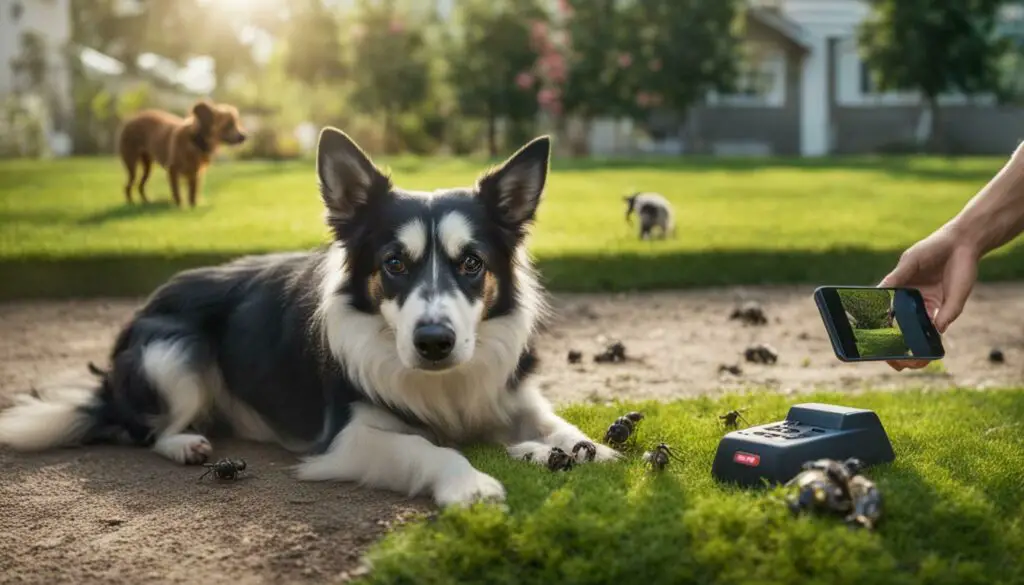
Additional Resources
If your dog has consumed an ant trap, these resources may provide further assistance:
“Acting quickly is crucial when your dog has consumed an ant trap, as prompt intervention can help minimize potential harm.”
By following these immediate actions and seeking professional advice, you can provide the necessary care and support for your dog when they have ingested an ant trap. Remember to prioritize their safety by keeping ant traps out of their reach and exploring safer alternatives for pest control in the future.
| Signs of Ant Trap Poisoning in Dogs | Immediate Care for Dog Who Ate Ant Trap |
|---|---|
| Vomiting | Assess your dog’s condition |
| Drooling | Contact a pet poison helpline or veterinarian |
| Difficulty breathing | Monitor for intestinal issues |
| Abdominal pain | Seek professional guidance before inducing vomiting |
Assessing Your Dog’s Condition
Before contacting a pet poison helpline or veterinarian, it’s important to carefully evaluate your dog’s condition to provide relevant information and ensure appropriate treatment.
Start by observing your dog for any immediate signs of distress or discomfort. Look out for symptoms such as excessive drooling, vomiting, diarrhea, or difficulty breathing. If you notice any of these symptoms, it is crucial to seek veterinary care immediately as they may indicate a severe reaction to the ant trap.
You should also check your dog’s mouth and throat for any visible damage. Ant traps typically contain chemicals that can cause irritation and burns. Look for redness, swelling, or ulcerations in these areas. If you notice any abnormalities, it is important to inform the veterinarian or poison control hotline.
Keep a close eye on your dog’s behavior and overall well-being in the following hours and days. Note any changes in appetite, energy levels, or bathroom habits. If you observe any unusual behavior or persistent symptoms, it is essential to reach out to a professional for guidance and further evaluation.
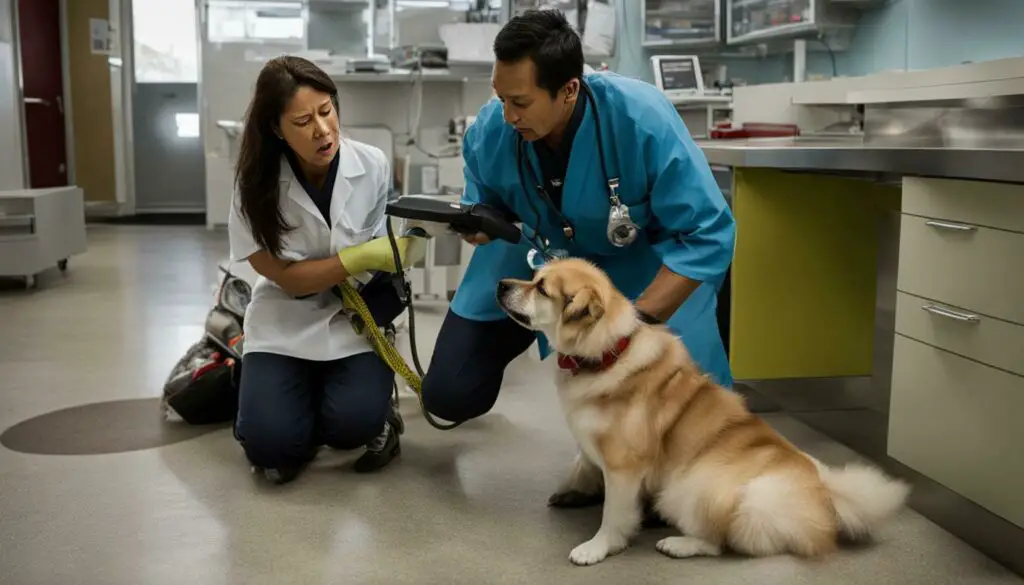
Contacting a Pet Poison Helpline or Veterinarian
Seeking expert advice is crucial to ensure your dog’s well-being after consuming an ant trap, so don’t hesitate to contact a pet poison helpline or your veterinarian. They can provide you with the necessary guidance and support tailored to your dog’s specific situation. It’s always better to be safe than sorry, especially when it comes to your furry friend’s health.
When reaching out to a pet poison helpline or veterinarian, be prepared to provide them with important information. This may include details about the ant trap your dog ingested, such as the brand name and active ingredients, as well as your dog’s breed, weight, and any symptoms they may be experiencing. The more specific information you can provide, the better equipped they will be to assist you effectively.
Keep in mind that timing is crucial in these situations. Some ant traps contain chemicals that can cause immediate adverse reactions, while others may have delayed effects. By contacting a professional as soon as possible, you can receive immediate advice on how to proceed and potentially minimize any potential harm to your dog.
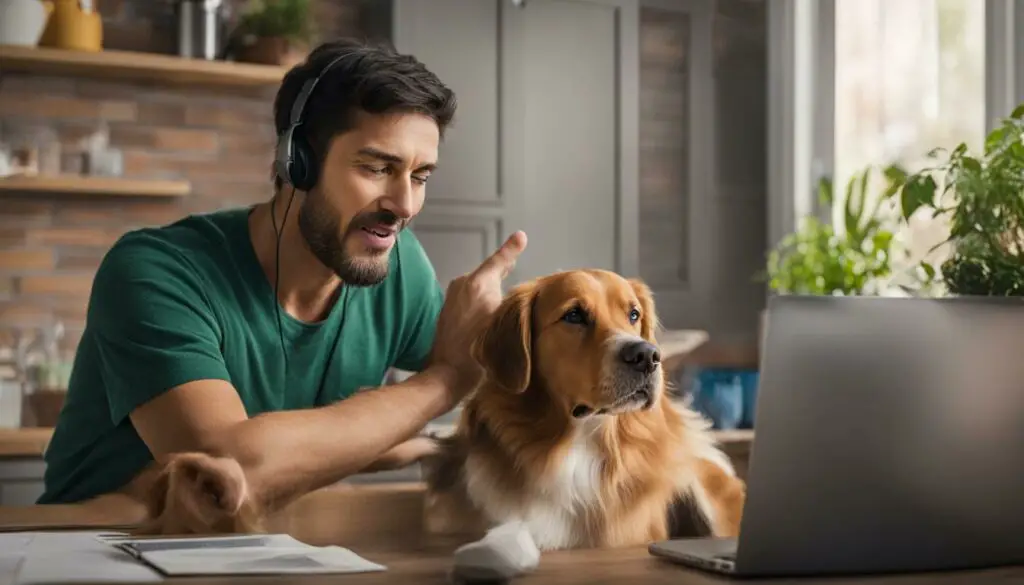
Monitoring Your Dog for Intestinal Issues
It’s essential to keep a close eye on your dog in the days following the ingestion of an ant trap, as complications like intestinal blockage or perforation can occur. While most ant traps are designed to be relatively safe for dogs, there is still a risk of physical damage to their digestive system if the trap was consumed in large quantities or contains toxic substances.
To monitor your dog for any potential issues, observe their behavior and watch for any changes in appetite, vomiting, diarrhea, or abdominal discomfort. If you notice any unusual symptoms or your dog appears to be in distress, it is important to seek veterinary attention immediately. Professional medical intervention will help determine the severity of the situation and provide the necessary treatment.
During this monitoring period, it is recommended to limit your dog’s activity level to prevent any further complications. Rest and quiet time can help reduce the risk of exacerbating any gastrointestinal issues that may arise as a result of the ant trap ingestion.
Signs of Intestinal Blockage or Perforation in Dogs
Intestinal blockage or perforation can have serious consequences for your dog’s health. Watch out for these signs that may indicate such complications:
- Severe abdominal pain or distension
- Lack of appetite and decreased water intake
- Persistent vomiting or retching
- Straining to defecate or absence of bowel movements
- Rectal bleeding or blood in the stool
If any of these symptoms occur, it is vital to seek immediate veterinary care. Your veterinarian can perform diagnostic tests such as X-rays or ultrasounds to assess the extent of the injury and recommend appropriate treatment options.
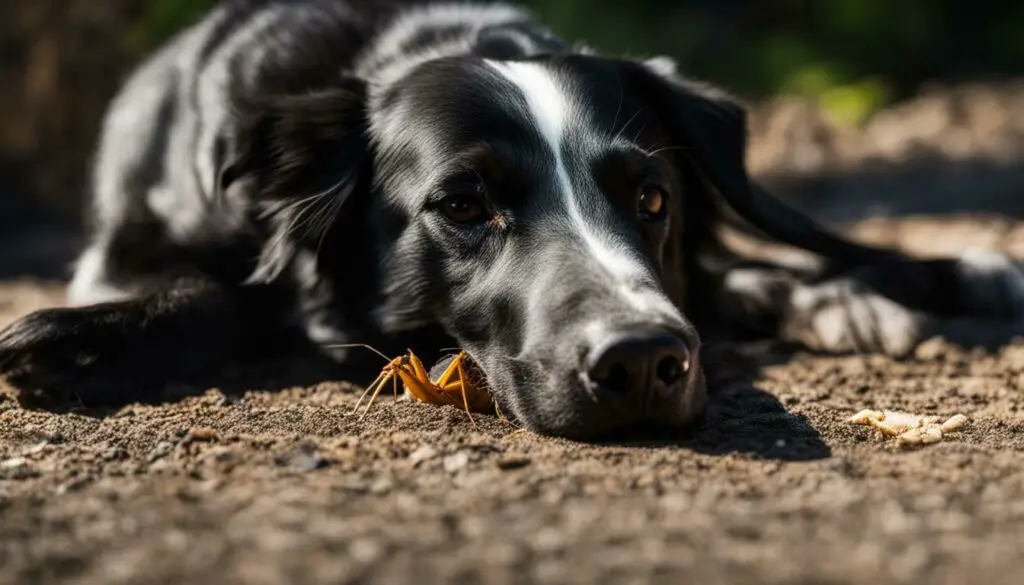
Preventing Future Incidents
Taking proactive measures can help prevent your dog from accessing ant traps and minimize the risk of any potential harm. Here are some tips to ensure the safety of your furry friend:
- Secure ant traps: Keep ant traps in areas that are completely inaccessible to your dog. Place them high up on countertops, shelves, or inside cabinets that cannot be opened by your pet.
- Use pet-friendly alternatives: Consider using safe and natural pest control methods that do not pose a risk to your dog. There are many pet-friendly alternatives available, such as diatomaceous earth or vinegar solutions, which can effectively deter ants without harming your furry friend.
- Regularly inspect your home: Conduct routine checks around your home to ensure there are no ant traps left out in places where your dog can reach. Be thorough in your search, especially in areas where ants might be attracted, such as the kitchen or outdoor spaces.
Taking these proactive steps can help create a safe environment and prevent any accidental ingestion of ant traps by your dog. It is always better to prioritize their well-being and choose safer alternatives for pest control.
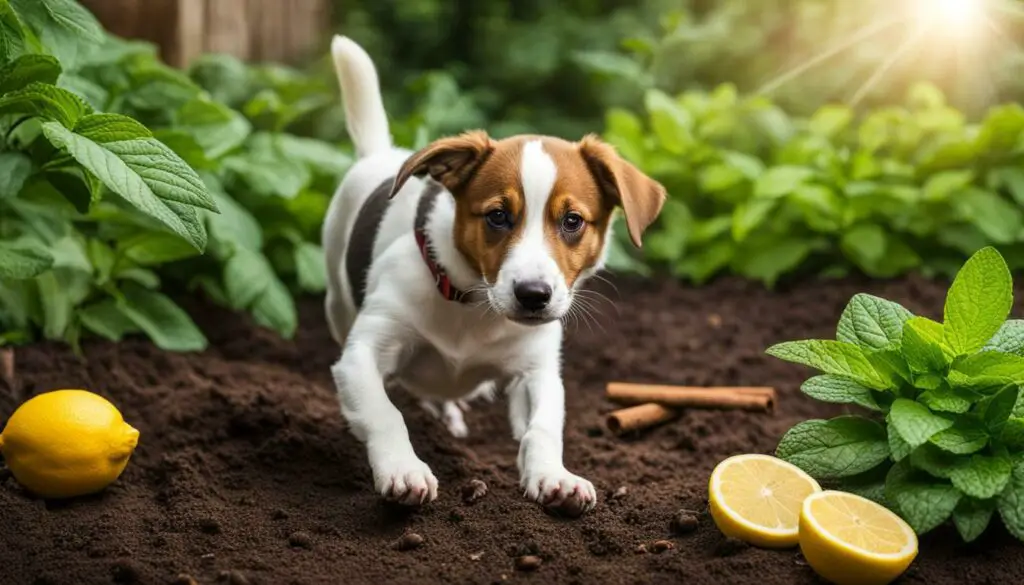
Safe Pest Control Methods for Dog Owners
When it comes to pest control, there are several dog-friendly options to consider:
| Pest Control Method | Description |
|---|---|
| Diatomaceous Earth | A natural, non-toxic substance that dehydrates and kills ants, while being safe for dogs and humans. |
| Vinegar Solution | A mixture of equal parts vinegar and water can be used to repel ants without posing any harm to your dog. |
| Natural Ant Repellent Sprays | There are commercially available ant repellent sprays that are specifically designed to be pet-friendly and safe for use around dogs. |
These alternatives can effectively control ant infestations without endangering your dog’s health. Always follow the instructions provided with each product for optimal results.
Safe Pest Control Methods for Dog Owners
Finding pest control methods that are both effective and safe for your dog is essential to maintain a healthy and hazard-free environment. While ant traps may seem convenient, they can pose risks to your furry friend if ingested. Fortunately, there are safer alternatives that can effectively keep ants at bay without endangering your dog’s well-being.
One option is to use natural repellents that are pet-friendly. Ingredients like vinegar, lemon juice, or essential oils such as peppermint, citronella, or lavender can deter ants without harming your dog. Simply mix these ingredients with water and spray the solution in areas prone to ant activity.
Another effective method is to use physical barriers. Seal cracks and crevices where ants can enter your home, and keep food stored in airtight containers to eliminate their food source. Additionally, creating a clean and clutter-free environment reduces the chances of attracting ants.
| Pest Control Method | Pros | Cons |
|---|---|---|
| Natural Repellents | – Safe for dogs – Environmentally friendly – Easy to make at home |
– May require more frequent application – Not as potent as chemical alternatives |
| Physical Barriers | – Non-toxic – Long-lasting effect – Prevents ants from entering |
– Requires time and effort to seal entry points – May not be suitable for all areas |
“Using natural repellents and physical barriers can effectively control ant infestations while protecting your dog from potential harm.” – Dr. Sarah Johnson, Veterinarian
Consulting with a professional
If you’re unsure of which pest control method to use or if you’re dealing with a severe infestation, it’s advisable to consult with a professional pest control service. They can assess your situation and recommend the most appropriate and safe solution for your home and your dog’s well-being.
By prioritizing your dog’s safety and implementing safe pest control measures, you can ensure a pest-free environment without compromising their health. Remember to regularly monitor your dog for any signs of discomfort or illness, and seek veterinary advice if necessary.

The Importance of Keeping Ant Traps Out of Reach
Proactive measures, such as properly storing ant traps away from your dog’s reach, serve as a vital preventive strategy against accidental ingestion. As a responsible dog owner, it is crucial to create a safe environment for your furry friend by taking steps to ensure they cannot access potentially harmful substances.
One effective way to keep ant traps out of your dog’s reach is by placing them in elevated areas or behind closed cabinets. This prevents curious noses and paws from coming into contact with these toxic products. Additionally, consider using ant traps that are specifically designed to be pet-friendly, containing ingredients that are safe for dogs. These traps are usually scent-free, making them less likely to attract your dog’s attention.
In households with children or multiple pets, it is important to educate all family members about the potential dangers of ant traps and the importance of keeping them inaccessible. Regularly inspect your home to ensure that no ant traps have been accidentally left within reach. By taking these preventive measures, you can greatly reduce the risk of accidental ingestion and safeguard your dog’s health.
| Preventive Measures | Benefits |
|---|---|
| Elevate ant traps or store in closed cabinets | Prevents dogs from accessing ant traps |
| Use pet-friendly ant traps | Reduces the risk of toxic ingestion |
| Educate family members about the dangers | Ensures everyone is aware of the potential risks |
| Regularly inspect your home | Identifies and removes any accessible ant traps |
Remember, prevention is always better than cure. By implementing these preventive measures, you can provide a safe and secure environment for your dog, minimizing the chances of them coming into contact with harmful substances.
By keeping ant traps out of your dog’s reach, you can significantly reduce the risk of accidental ingestion and potential health complications. Remember to prioritize your dog’s safety by exploring safer alternatives for pest control and ensuring that any toxic products are stored securely. Your dog’s well-being is in your hands, so take the necessary steps to protect them from harm.
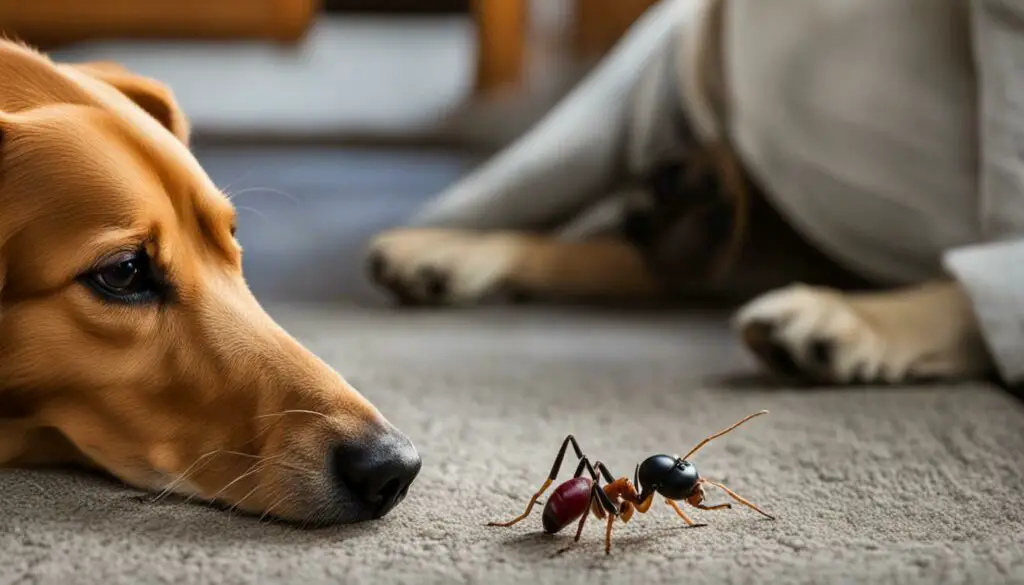
Ant Trap Poisoning in Dogs: Frequently Asked Questions
Understanding the concerns and questions that arise when your dog ingests an ant trap is important for their prompt care and overall well-being. While most ant traps won’t cause serious harm to dogs, it is crucial to be prepared and take necessary actions in case of potential adverse health reactions.
Here are some frequently asked questions regarding dog ingestion of ant traps:
- What should I do if my dog ate an ant trap? If your dog has consumed an ant trap, start by assessing their condition. Check for any visible damage to their mouth or throat. Contact a pet poison helpline or veterinarian immediately and provide them with information about the specific ant trap and your dog’s health.
- What are the signs of ant trap poisoning in dogs? Some signs of ant trap poisoning may include drooling, vomiting, diarrhea, lethargy, tremors, or difficulty breathing. However, it is important to note that the severity of symptoms can vary depending on the type and amount of ant trap ingested.
- How can I prevent my dog from eating ant traps? To prevent accidental ingestion, keep ant traps out of your dog’s reach. Opt for safer alternatives to protect your home from ants and other pests, such as natural repellents or pet-friendly pest control methods.
Remember to monitor your dog for any signs of intestinal blockage or perforation in the following 48 hours after ingesting an ant trap. Seek professional veterinary care for a comprehensive assessment and personalized advice based on your dog’s specific situation. By promoting a safe environment and taking swift action, you can ensure your dog’s health and well-being.
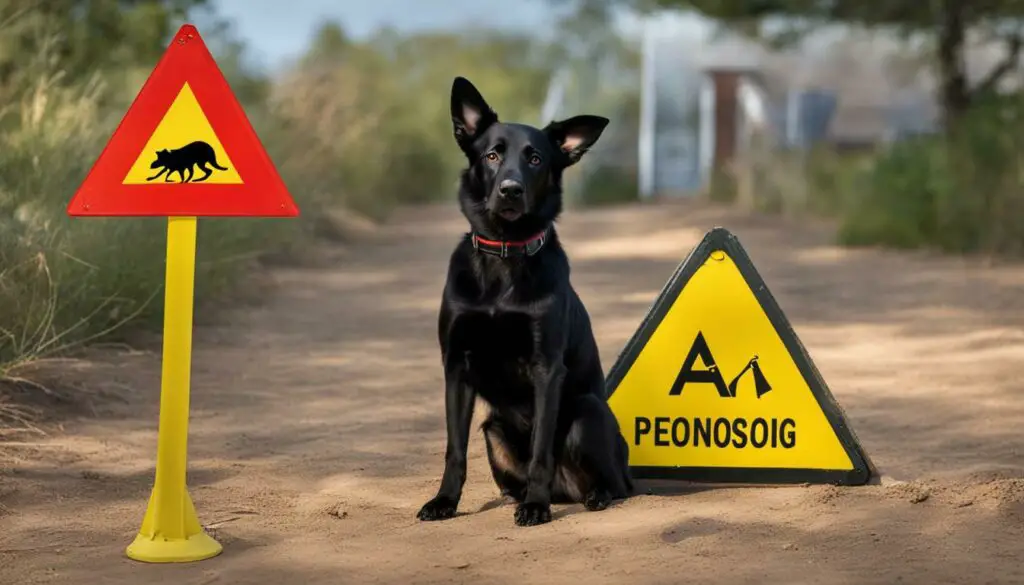
| Common Questions | Answers |
|---|---|
| Can ant traps cause serious harm to dogs? | While most ant traps are unlikely to cause serious harm, it is best to monitor your dog for any adverse reactions and seek professional advice. |
| What should I do if my dog exhibits symptoms of ant trap poisoning? | If your dog shows signs of poisoning, such as vomiting or difficulty breathing, contact a pet poison helpline or veterinarian immediately. |
| Are there safer alternatives to ant traps? | Yes, consider using natural repellents or pet-friendly pest control methods as alternatives to ant traps to ensure your dog’s safety. |
| How can I prevent future incidents? | Keep ant traps out of your dog’s reach, and explore safer pest control options to minimize the risk of accidental ingestion. |
Remember, the health and well-being of your furry friend should always be a top priority. Stay informed, take necessary precautions, and seek professional guidance when needed to protect your dog from the dangers of ant traps.
Seeking Professional Veterinary Care
While this article aims to provide helpful guidance, it’s essential to consult a veterinarian for personalized advice and support when dealing with a dog that has consumed an ant trap. Although most ant traps won’t cause serious harm to dogs, it’s best to err on the side of caution and seek professional veterinary care.
When you contact a veterinarian, provide them with as much information as possible about the ant trap your dog ingested. This includes the brand, active ingredients, and any symptoms your dog may be experiencing. The veterinarian will be able to assess the potential risks and provide tailored advice for your specific situation.
Remember, veterinarians are trained professionals who possess the knowledge and expertise to accurately diagnose and treat your dog. They may recommend additional tests, administer appropriate treatments, or provide guidance on monitoring your dog’s condition at home. It’s important to follow their instructions diligently for the well-being of your furry friend.
By seeking professional veterinary care, you can ensure that your dog receives the necessary support and treatment they require after ingesting an ant trap. Veterinarians play a crucial role in safeguarding your dog’s health, and their expertise is invaluable in these situations. Always prioritize the well-being of your pet and reach out to a veterinarian as soon as possible when faced with such an incident.
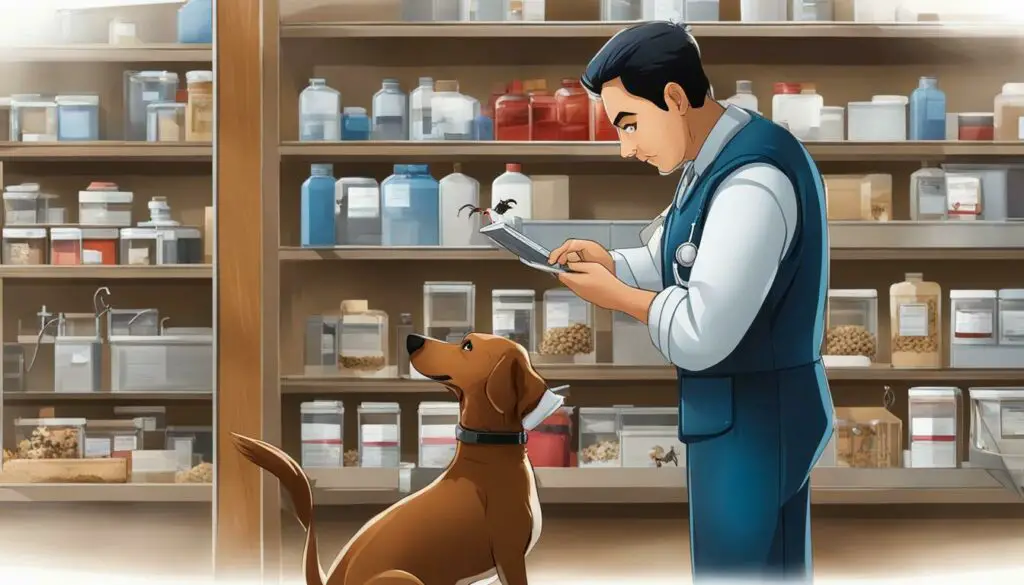
| Summary of Section 11: Seeking Professional Veterinary Care | |
|---|---|
| Key Points | SEO Keywords |
| Consult a veterinarian for personalized advice and support | veterinarian advice for dog who ate ant trap |
| Provide detailed information about the ant trap to the veterinarian | veterinarian advice for dog who ate ant trap |
| Follow the veterinarian’s instructions diligently | veterinarian advice for dog who ate ant trap |
| Seek professional veterinary care to ensure appropriate treatment | veterinarian advice for dog who ate ant trap |
Promoting a Safe Environment for Your Dog
By taking proactive steps and prioritizing your dog’s safety, you can ensure a healthy and secure environment for them to thrive in. Preventing your dog from eating ant traps is crucial to avoiding potential health risks. Here are some effective strategies to create a safe space for your furry friend:
- Keep ant traps out of reach: Store ant traps in areas that your dog cannot access, such as locked cabinets or high shelves. This will minimize the chances of accidental ingestion and protect your pet from harm.
- Choose safe alternatives: Instead of using ant traps that contain harmful chemicals, opt for pet-friendly methods of pest control. Natural options like vinegar, lemon juice, or cinnamon can help deter ants without posing any risks to your dog’s health.
- Seal entry points: Ants typically enter your home through cracks and openings in doors, windows, or walls. Seal these entry points to prevent ants from getting inside in the first place, reducing the need for ant traps altogether.
- Maintain cleanliness: Regularly clean up food spills, crumbs, and trash, as these can attract ants. By keeping your home clean and free from potential ant food sources, you’ll discourage their presence and minimize the need for pest control measures.
Remember, prevention is key when it comes to safeguarding your dog’s well-being. By implementing these measures, you can protect your beloved pet from the dangers of ant traps and ensure their environment remains safe and free from harmful substances.
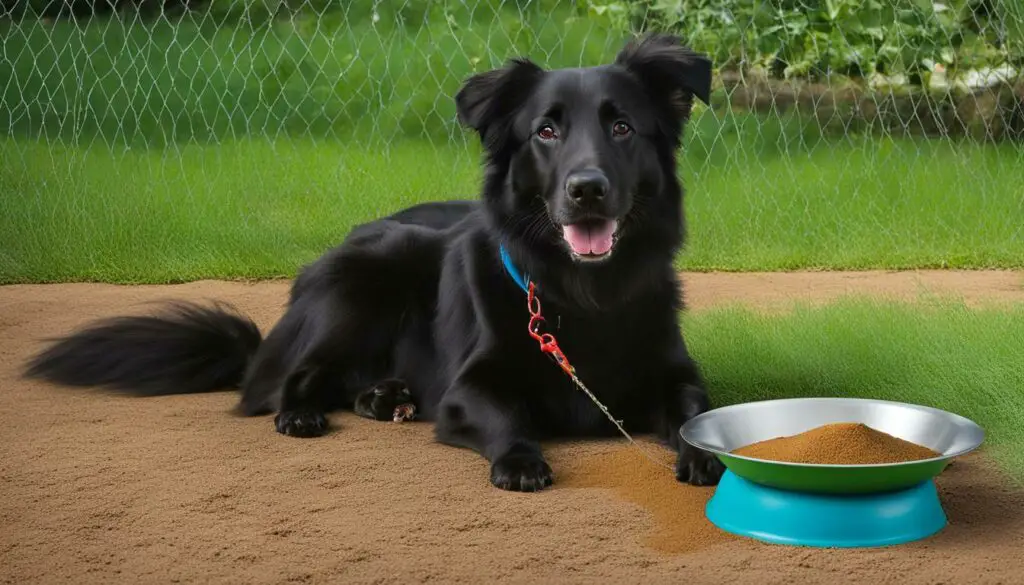
| Question | Answer |
|---|---|
| Can ant traps cause serious harm to dogs? | Most ant traps are not highly toxic to dogs, but it’s best to be cautious and monitor your pet for any adverse reactions. |
| What should I do if my dog eats an ant trap? | Take immediate action by assessing your dog’s condition, checking for any mouth or throat damage, and contacting a pet poison helpline or veterinarian for guidance. |
| How can I prevent my dog from eating ant traps in the future? | Keep ant traps securely stored out of your dog’s reach, and consider using safe alternatives for pest control, such as natural repellents or professional pet-friendly services. |
Taking Swift Action for Your Dog’s Health
Remember, quick action and expert guidance are vital when your dog ingests an ant trap, ensuring their health and well-being. If you find yourself in this situation, there are immediate actions you can take to help your furry friend.
First and foremost, assess your dog’s condition. Look for any signs of distress or unusual behavior. Check their mouth and throat for any visible damage caused by the ant trap. If you notice anything concerning, it is crucial to seek prompt veterinary care.
Next, contact a pet poison helpline or your veterinarian for professional advice. Provide them with information about the specific ant trap your dog ate and any potential symptoms or changes in behavior you have observed. They will be able to guide you on the best course of action based on your dog’s size, health, and the ingredients of the ant trap.
It is essential to monitor your dog closely in the following 48 hours for any signs of intestinal issues. Keep an eye out for symptoms such as vomiting, diarrhea, abdominal pain, or difficulty passing stool. If you notice any concerning signs, contact your veterinarian immediately.
To prevent future incidents, make sure to keep ant traps out of your dog’s reach. Store them in secure, elevated places or switch to safer alternatives for pest control. There are pet-friendly pest control methods available that can effectively eliminate ants without posing a risk to your furry companion.
By taking swift action, seeking professional guidance, and implementing preventive measures, you can ensure your dog’s health and create a safe environment for them to thrive. Remember, your veterinarian is the best resource for tailored advice related to your dog’s specific situation. Stay informed and proactive to keep your four-legged friend happy and healthy.
FAQ
What should I do if my dog has eaten an ant trap?
It is important to monitor your dog for symptoms and contact a pet poison hotline or veterinarian for guidance. Most ant traps won’t cause serious harm, but it’s best to be prepared for potential adverse health reactions.
Are ant traps dangerous for dogs?
While most ant traps won’t cause serious harm to dogs, they can still pose risks. It’s important to keep them out of your dog’s reach and consider safer pest control methods in the future.
What immediate actions should I take if my dog ate an ant trap?
Assess your dog’s condition and check for any damage to the mouth or throat. Immediately contact a pet poison helpline or veterinarian to provide information about the trap and your dog’s health.
How can I assess my dog’s condition after eating an ant trap?
Look out for signs of poisoning and check for any visible damage to the mouth or throat. Monitor your dog closely for any unusual symptoms or behavior.
Should I contact a pet poison helpline or veterinarian?
Yes, it is important to reach out to a pet poison helpline or veterinarian for professional guidance in handling ant trap ingestion cases. They can provide the most accurate advice based on your dog’s specific situation.
What should I do if my dog shows signs of intestinal issues after eating an ant trap?
Monitor your dog closely for signs of intestinal blockage or perforation. If you notice any concerning symptoms such as vomiting, loss of appetite, or abdominal pain, contact your veterinarian immediately.
How can I prevent my dog from eating ant traps in the future?
Keep ant traps out of your dog’s reach by placing them in areas your dog cannot access. Additionally, consider using safer alternatives for pest control and consult with a professional for recommendations.
What are safe alternatives to ant traps for dog owners?
There are several safe alternatives to ant traps that are suitable for dog owners. These may include natural pest control methods, pet-friendly repellents, or seeking professional pest control services that prioritize pet safety.
Why is it important to keep ant traps out of my dog’s reach?
It is crucial to keep ant traps away from your dog to prevent accidental ingestion and potential harm. Dogs are curious animals and may be attracted to the scent or taste of ant traps, leading to ingestion and possible health complications.
What are some frequently asked questions about ant trap poisoning in dogs?
Common questions include what to do if a dog eats an ant trap, the dangers of ant traps for dogs, and how to prevent these incidents from happening.
When should I seek professional veterinary care for my dog who ate an ant trap?
It is important to seek professional veterinary care if your dog shows any concerning symptoms or if you have any doubts about their well-being. A veterinarian can provide the most accurate and tailored advice for your specific situation.
How can I promote a safe environment for my dog regarding ant traps?
Create a safe environment for your dog by implementing preventive measures such as keeping ant traps out of their reach and utilizing pet-friendly pest control methods. Prioritize your dog’s safety when choosing pest control products.
Why is it important to take swift action for my dog’s health after eating an ant trap?
Taking immediate action is crucial to ensure the well-being of your dog. Monitor for symptoms, assess their condition, and contact a pet poison helpline or veterinarian for guidance. Prompt action can help prevent potential complications and provide appropriate care.
Source Links
- https://www.petpoisonhelpline.com/pet-tips/ant-poison-and-dogs-everything-a-dog-owner-needs-to-know/
- https://www.hepper.com/dog-ate-ant-trap-vet-answer/
- https://www.k9ofmine.com/dog-ate-ant-trap/

